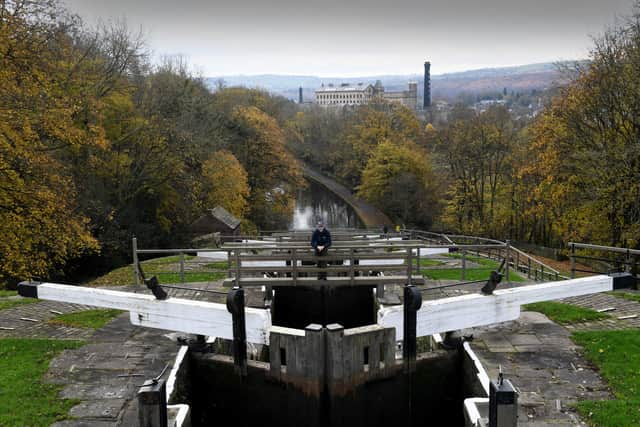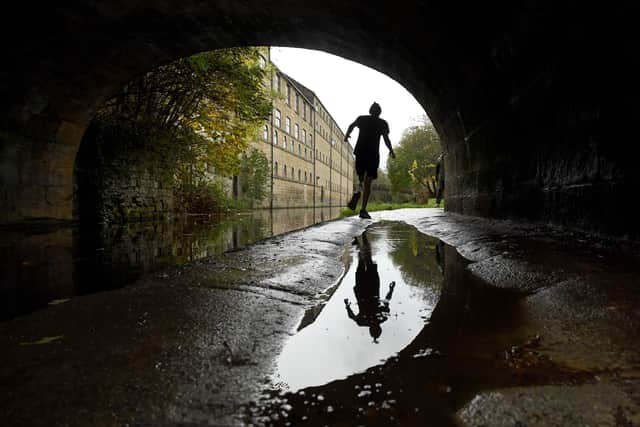Wars of the roses subside for 250th anniversary of Leeds and Liverpool Canal
The Leeds and Liverpool Canal was the waterway that helped bring wool and wealth to Yorkshire, but its story is one of internecine rivalry on both sides of the Pennines which threatened to divert or even destroy it before it was finished. Yet without it, the industrial revolution might have bypassed the Northern towns it helped prosper.
It was in November 1770, just outside Ormskirk, that the first sod was cut on what was to become a 127m superhighway from the Yorkshire coalfields to the port of Liverpool. Two and a half centuries on, the rival factions that saw it to completion eventually buried the hatchet. Representatives of the Yorkshire Ridings Society and the Friends of Real Lancashire gathered as close to the spot as social distancing would allow, and raised their respective flags.
Advertisement
Hide AdAdvertisement
Hide AdPhilip Walsh, a retired policeman from the mounted division, who chairs the Lancashire organisation and who had not long since walked the length of the canal to raise money for charity, invited Eric Scaife, his opposite number from east of the Pennines, to join him in the discreet festivities.


“I decided that the anniversary couldn’t be missed without some sort of celebration,” he said. Mr Scaife added that since there was no record of where the first Yorkshire sod had been cut, Lancashire was an appropriate location.
There had been no such co-operation among their 18th century forebears. William Froggatt, heritage adviser to the Canal and River Trust, which now operates the canal, said the arguments continued across the hills through the 46 years it took to finish.
“Despite its name, it was the merchants of Bradford, not Leeds or Liverpool, who promoted it,” he said.
Advertisement
Hide AdAdvertisement
Hide Ad“They established two organising committees, one headquartered in Bradford, the other in Liverpool, and each wanted something different from the canal.


“The people of Yorkshire wanted the quickest route to Liverpool, and those in Lancashire wanted access to the coalfields around Wigan. So they couldn’t agree on the route.”
Yorkshire won the argument, only to preside over a U-turn some 20 years later. As a result of the disagreements – and the interruption of the American War of Independence which pushed up labour costs as young men joined the army – it was not until 1816 when the excavation teams from east and west met in the middle.
Almost immediately, the boats began to revolutionise the towns through which they passed.
Advertisement
Hide AdAdvertisement
Hide Ad“Places like Burnley and Blackburn were just market towns when the canal arrived,” Mr Froggatt said. “But Burnley in particular became one of the world’s largest producers of cotton cloth, and it was only able to do that because it could now get its raw materials from America via Liverpool, its coal to power the looms via the canal, and then having produced the cloth it could get it to Liverpool or Hull to export it.
“You could probably say the same for all the industry along the path of the canal.”
The exception was Bradford itself – which the canal bypassed, despite the efforts of John Hustler, one of the founding fathers of the city’s wool trade. A separate, three-and-a-half mile waterway which connected the main canal to the city, was opened in 1774 but closed in 1866 and later filled in.
“The Bradford Canal didn’t have a good source of water and it wasn’t successful at all. It’s another example of how the city fell by the wayside while Leeds prospered,” Mr Froggatt said.
Advertisement
Hide AdAdvertisement
Hide AdYet the argument and engineering that produced the main waterway was a feat worth remembering, he added.
“It’s important we celebrate milestones like this, because without the canal and the access it brought to coal and limestone, the industrial revolution may not have happened.”
• At its peak in 1866, the Leeds and Liverpool canal carried nearly 2m tons of coal. And unlike most canals it survived the competition the railways created from the 1840s.
Even after the Second World War, as England’s canals gradually fell into disuse, it continued to carry coal between the pits and power stations – until a series of severe winters in the 1960s froze it over and caused hauliers to turn to the roads. When the thaw came, they never returned.
Advertisement
Hide AdAdvertisement
Hide AdBut the Transport Act of 1968 brought about a renaissance, and an estimated 400m visits are now made each year by walkers, anglers, boaters, anglers and runners.
“At the time a lot of the canals were full of rubbish. And the 1968 Act gave them a new lease of life,” said Mr Froggatt. “Today for many people in urban areas a canal is the only place they can go to exercise.”
Support The Yorkshire Post and become a subscriber today. Your subscription will help us to continue to bring quality news to the people of Yorkshire. In return, you’ll see fewer ads on site, get free access to our app and receive exclusive members-only offers. Click here to subscribe.
Comment Guidelines
National World encourages reader discussion on our stories. User feedback, insights and back-and-forth exchanges add a rich layer of context to reporting. Please review our Community Guidelines before commenting.